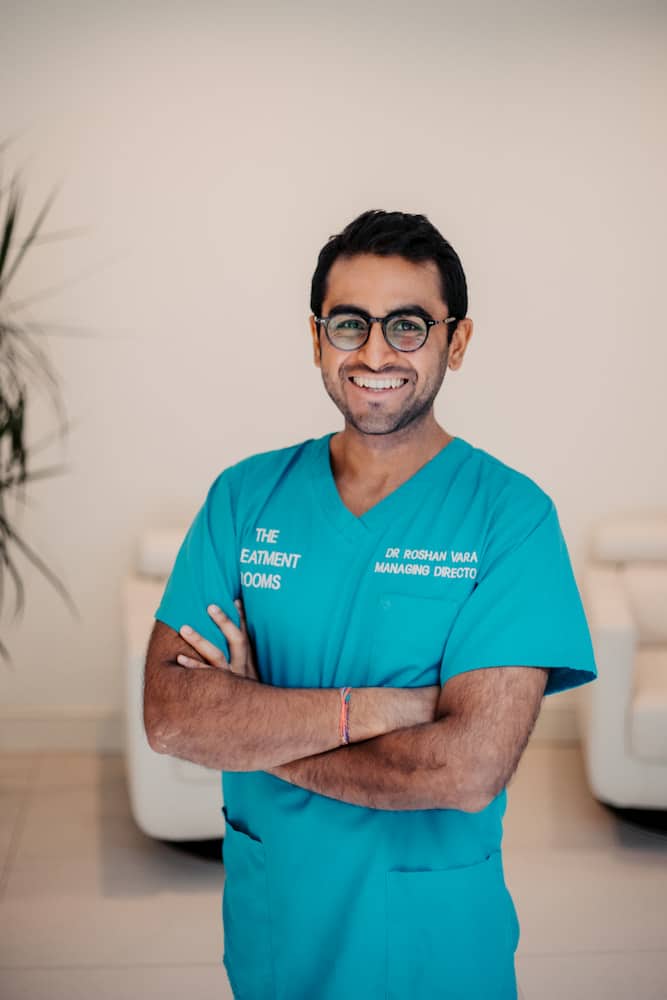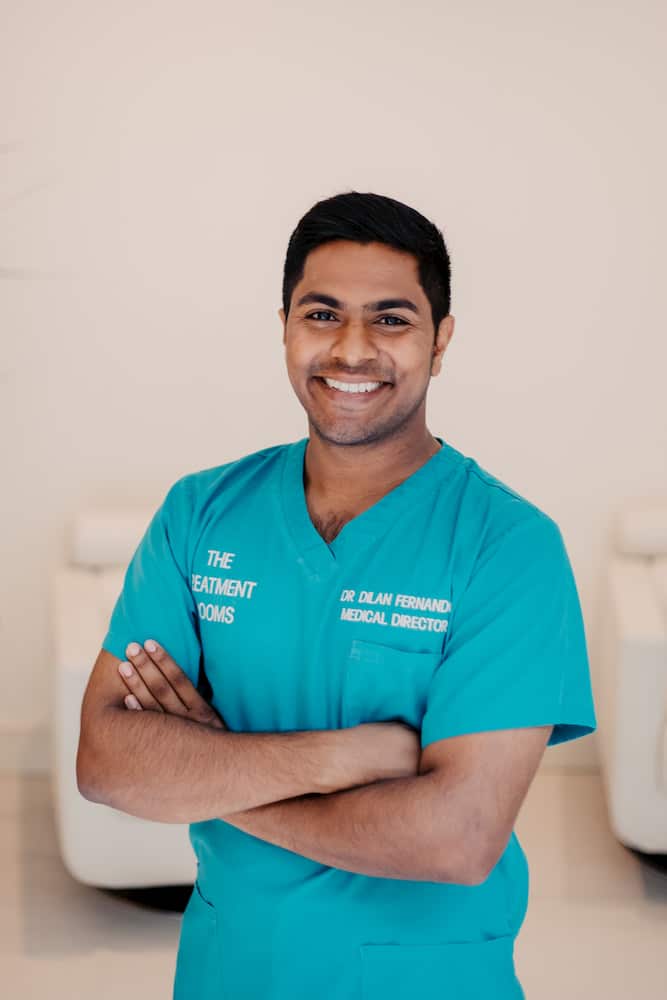Quick Summary: Eyebrows & Minoxidil
Understanding Eyebrow Hair Loss: Losing eyebrow hair can deeply impact how confident you feel about your face and identity. This loss is commonly caused by over-plucking but can also be due to autoimmune diseases, hormonal imbalances, genetic factors, nutritional deficiencies, infections, and physical injury.
Introducing Minoxidil: Initially a blood pressure medication, Minoxidil has shown promise in enhancing eyebrow fullness by stimulating growth, and extending each hair cycle’s growth phase.
Application Guidelines: For effective results, apply Minoxidil precisely to the scalp using a small applicator or cotton swab, twice daily. Start with a 2% concentration to minimise irritation, with the option to increase to 5% if well-tolerated.
Expected Results and Timeline: Initial signs of regrowth can appear within 2-3 months, with significant improvements usually visible by the 4-month mark. Results may vary based on individual factors like age and health.
Potential Side Effects: While generally safe, Minoxidil can cause skin irritation, redness, or unintended hair growth if applied imprecisely.
Alternatives to Minoxidil: Options include natural oils like castor oil, biotin supplements, microblading for semi-permanent tattoo enhancement, and eyebrow hair transplants for permanent results.
Key Takeaway: Minoxidil offers a hopeful solution for those experiencing eyebrow hair loss. With proper use and professional guidance, it’s possible to restore eyebrow density and boost self-confidence. Remember, treatment journeys begin with an understanding of causes, and end with finding the right solution for you.
This blog explores Minoxidil’s journey from a heart medication to a promising eyebrow enhancer. We’ll cover its mechanism, application tips, and realistic outcomes of its use. Read on to discover how this treatment could help regain your eyebrows’ natural definition, and boost your confidence.
Understanding Eyebrow Hair Loss
Complete, or partial loss, of eyebrow or eyelash hair is known medically as “madarosis”. This hair loss is caused by ailments like autoimmune conditions, hormonal problems, genetics, infections, poor nutrition and physical injury.1
Some of the main causes of eyebrow and eyelash hair loss are listed below1:
- Autoimmune: Alopecia areata, an autoimmune disease, leads to patchy eyebrow loss due to the body’s immune system attacking hair follicles. The disease’s impact on eyebrows varies by genetics – for example, 20% of Japanese and 63% of Danish individuals with the condition experience eyebrow loss. Frontal Fibrosing Alopecia, another result of immune system dysfunction and hormonal changes, causes gradual hairline recession, and eyebrow thinning or loss.
- Hypothyroidism: Hypothyroidism is a condition in which your thyroid gland doesn’t produce enough thyroid hormones, slowing down your body’s metabolism. This can lead to loss of the outer parts of your eyebrows, as low levels of thyroid hormones affect hair growth cycles.
- Genetics: There are a few genetic disorders that play a significant role in eyebrow loss, as genetics can control hair density and longevity. Having certain genes can lead to naturally sparse or thinning eyebrows over time (e.g. hereditary hair loss, KFSD, TIDAND)
- Infections: A diverse range of infections can impact hair growth. Infectious diseases like leprosy, syphilis, and fungal infections can cause eyebrow loss. This loss can occur in unique patterns or in specific areas. Certain viruses, like the virus that causes Shingles, can also cause eyebrow hair loss.
- Nutritional: Some findings have shown that not getting enough zinc in your diet can lead to thinning eyebrows and eyelashes. Some good sources of zinc are oysters, crab, dark meat, leafy vegetables, legumes, nuts, and seeds.
- Physical Injury: Eyebrow loss can also happen from frequent rubbing, scratching, or pulling at the hairs, which might be due to skin issues like eczema or psoriasis, or stress-related habits like trichotillomania.
In a study following women with breast cancer who experienced eyebrow loss, over 50% were concerned with others’ perceptions of their appearances, and 25% faced anxiety.1 This underscores the profound impact of eyebrow hair loss on self-image, and the importance of finding solutions for hair regrowth to ease emotional distress. For further guidance, you can read our comprehensive guide on dealing with eyebrow hair loss here.
Minoxidil
Minoxidil and How It Works
Minoxidil was originally used as a blood pressure medication in the 1970s. A surprising side effect of this medication was improved hair growth. This led to the creation of a topical formula designed specifically to encourage hair regrowth, and Minoxidil became a go-to solution to treat male and female androgenetic alopecia (pattern hair loss).
Minoxidil treatment is available over the counter in various forms, including liquid solutions, lotions, and foams, with concentrations ranging from 2% to 5%.
Forms Available Over the Counter:
- Liquid solution and lotion in 2% and 5% concentrations.
- Foam version, 5%, favoured for being less irritating, drying faster, and minimal spread beyond application area.
So, how does Minoxidil work?
At its core, Minoxidil potentially widens tiny blood vessels in the scalp, which improves blood flow to hair follicles. This process gas been shown to:
- Revive and extend the growth (anagen) phase of the hair cycle, while shortening its time in resting (telogen) phase.
- Stimulates hair follicle activity and increases follicle size.
- Boosts the production of certain growth factors that are crucial for hair development.2
By doing all of this, Minoxidil not only encourages new hair growth but also helps maintain it, making it a valuable tool in the fight against hair loss. Its broader applications include:
- Off-label treatment for hair disorders like alopecia areata, scarring alopecia, chemotherapy-induced hair loss, and telogen effluvium.
- Use for the cosmetic enhancement of beards and eyebrows, showcasing its versatility.2
Something to note: Interestingly, a study revealed that taking low-dose aspirin might lessen Minoxidil’s effectiveness, showing a 23% reduction in how well participants responded to the hair growth treatment.3 However, this is an initial finding, so it’s important not to change any aspirin regimen without first consulting a healthcare professional. Always prioritise guidance from your doctor or a medical specialist when considering your treatment options.
Minoxidil for Eyebrows
Research Highlights on Minoxidil Use For Eyebrow Growth
Though mostly known for treating scalp hair loss, recent studies reveal Minoxidil’s effectiveness in promoting eyebrow growth, with studies demonstrating significant improvements in eyebrow fullness and thickness. These investigations, although smaller in scale, consistently demonstrate positive results.
The study’s results are summarised below if you’re interested:
- 2013 Study (40 Patients): Demonstrated that 2% minoxidil lotion, when applied to eyebrows, significantly improves their fullness, thickness, and hair count within 16 weeks. Only minor side effects were reported, underscoring its safety.4
- Follow-up Study (42 Participants): Showed that 1% minoxidil lotion enhances eyebrow appearance and thickness, making it a well-accepted treatment among users. Despite minor side effects like itching and burning, minoxidil stands out as a promising option for achieving fuller eyebrows.5
- Additional Research (22 Participants): Highlighted that twice-daily application of 2% minoxidil lotion for four months leads to notably thicker and denser eyebrows. Participants were happier with the look of their eyebrows, with mild itching reported as a minor side effect, further confirming the treatment’s efficacy and safety.6
From these findings, we can see that minoxidil, in both 1% and 2% concentrations, is a viable and safe method for enhancing eyebrow density and appearance.
Mechanism of Minoxidil Action On Eyebrow Follicles
The mechanism by which Minoxidil stimulates eyebrow growth is believed to be like that on the scalp – by enhancing blood flow, rejuvenating eyebrow hair follicles, and extending each hair’s growth phase.
Benefits of Minoxidil for Eyebrows
The benefits of minoxidil for eyebrows include:
- Stimulating Hair Growth: Minoxidil has been shown to increase hair growth by extending the anagen phase (growth phase) of the hair cycle. This means more time for your eyebrow hair to grow longer and thicker. The hair growth cycle is explained in the diagram below.

- Reducing Hair Loss and improving density: By decreasing the number of hair follicles in the telogen phase (resting phase), Minoxidil helps reduce hair loss, ensuring that more hair stays in the growth phase, leading to fuller and more defined eyebrows.
- Easy to Use: As a topical solution, Minoxidil is straightforward to apply directly to the eyebrows, making it a convenient option for daily use.
- Minimally Invasive: Unlike surgical options, Minoxidil is a non-surgical treatment for eyebrow hair loss, offering a less invasive way to achieve desired results.
How to Use Minoxidil for Eyebrows

- Apply with Precision: Use Minoxidil carefully around your eyebrows to avoid accidental hair growth in unwanted areas and keep it away from your eyes.
- How to Apply: Use a small applicator or cotton swab for direct application onto the eyebrow area. This ensures precise application.
- Frequency: Apply twice a day for best results.
- Choose the Right Concentration:
- Start Low: Begin with a 1% or 2% Minoxidil concentration to reduce the chances of irritation or side effects.
- Consider Increasing: If you tolerate the 1% or 2% solution well, and want quicker results, you can cautiously try the 5% concentration.
- Timeline from application to results:
- Initial Signs: Eyebrow regrowth may begin within 2-3 months of daily use.
- Peak Improvements: Most noticeable changes are typically seen by the 4-month mark if applied consistently, aligning with research findings mentioned above.
The timeline for seeing results can vary widely depending on individual factors such as age, health, and the cause of eyebrow thinning. It is important to stay patient and consistent with treatment.
Potential side effects of using Minoxidil on eyebrows:
- Skin Irritation: You might experience mild itching or burning in the applied area.
- Dry Skin: You can apply hair oil or cream to the area to help relieve this symptom
- Redness: The skin around the eyebrows can become red.
- Unwanted Hair Growth: If the solution spreads beyond the intended area, it could stimulate hair growth in these spots
- Allergic Reactions: Although rare, some individuals may be allergic to Minoxidil and experience reactions like severe itching. Stop using Minoxidil and consult with your healthcare provider if this occurs.
For more information on Minoxidil’s side effects, you can read our comprehensive blog over here.
Alternatives to Minoxidil for Eyebrow Enhancement
For fuller eyebrows without Minoxidil, you can consider alternatives, each with their own unique benefits:
- Natural Oils: Specifically castor oil, is a popular choice due to its potential to thicken up and strengthen eyebrow hair over time. Rich in fatty acids, castor oil is believed to nourish hair follicles, though further research is needed in this area.
- Biotin Supplements: Supports overall hair health, possibly improving eyebrow growth. It is important to consult your healthcare provider before starting any supplement regimen.
- Microblading: A semi-permanent tattooing technique that enhances eyebrow appearance instantly by adding pigment to the skin.
- Eyebrow hair transplant: A permanent method transferring hair to the eyebrows for a natural look, suitable for those with sparse brows. The typical eyebrow hair transplant cost is between £3,000 and £5,000.
Consulting with a hair transplant surgeon
At The Treatment Rooms London, our expertise in eyebrow hair loss allows us to assist you in your journey. Our skilled surgeons specialise in eyebrow hair transplants using the FUE technique, ideal for those with sparse or no eyebrows, aiming to restore or create natural-looking brows. We also specialise in performing unshaven hair transplant surgery for the eyebrows allowing patients to go back to work quicker after their procedure.
As the 2023 Hair Restoration Clinic of the Year, we’re dedicated to providing expert care. Book a consultation with us for personalised advice on tackling eyebrow hair loss.
Conclusion
Navigating the path to fuller eyebrows is made easier with options like Minoxidil and its alternatives. While not without potential side effects, proper application and concentration can minimise risks. Each available treatment for eyebrow hair loss offers a unique approach to enhance eyebrow density and appearance, underlining the importance of informed choices and professional guidance. With the right treatment and care, achieving your desired eyebrow look is more accessible than ever.
References
- Nguyen, B., Hu, J. K., & Tosti, A. (2023). Eyebrow and Eyelash Alopecia: A Clinical Review. American journal of clinical dermatology, 24(1), 55–67. https://doi.org/10.1007/s40257-022-00729-5
- Suchonwanit, P., Thammarucha, S., & Leerunyakul, K. (2019). Minoxidil and its use in hair disorders: a review. Drug design, development and therapy, 13, 2777–2786. https://doi.org/10.2147/DDDT.S214907
- Goren, A., Sharma, A., Dhurat, R., Shapiro, J., Sinclair, R., Situm, M., Kovacevic, M., Lukinovic Skudar, V., Goldust, M., Lotti, T., & McCoy, J. (2018). Low-dose daily aspirin reduces topical minoxidil efficacy in androgenetic alopecia patients. Dermatologic therapy, 31(6), e12741. https://doi.org/10.1111/dth.12741
- Lee, S., Tanglertsampan, C., Tanchotikul, M., & Worapunpong, N. (2014). Minoxidil 2% lotion for eyebrow enhancement: a randomized, double-blind, placebo-controlled, split-face comparative study. The Journal of dermatology, 41(2), 149–152. https://doi.org/10.1111/1346-8138.12275
- Worapunpong, N., & Tanglertsampan, C. (2017). Treatment of Eyebrow Hypotrichosis with 1 % Minoxidil Lotion : A Prospective, Randomized, Double-Blind, Placebo-Controlled Trial. Available from: https://www.thaiscience.info/journals/Article/JMAT/10986273.pdf
- Gajbhiye, V., & Lamture, Y. (2020). Minoxidil a Youth Elixir for Eyebrow Hypotrichosis. Journal of Clinical and Diagnostic Research. 14. https://doi.org/10.7860/JCDR/2020/42801.13474
Share:
Authored by
Reviewed by
Book a Consultation
Related Blogs
Does Hair Dye Cause Hair Thinning? Understanding the Risks and Facts
July 8, 2025
Have you noticed more hair loss after dyeing your hair? The ingredients in some dyes can be…
When Can You Safely Wear a Beanie After a Hair Transplant?
July 3, 2025
Quick Summary Cap Recommendations: Light, breathable caps, such as snapbacks or trucker hats, are advisable if you need…
Castor Oil (Ricino Oil) for Hair Growth: Benefits, Uses & How to Apply for Maximum Results
June 26, 2025
Castor oil, also known as Ricino oil, is extracted from the Castor bean plant (Ricinus communis). During…
What is a Hair Transplant? How it Works, Success Rate & What to Expect
June 23, 2025
Hair transplantation is a cosmetic surgical procedure that restores hair by moving healthy follicles from one part…
John Cena Hair Transplant
May 14, 2025
John Cena, a common household name, is a figure who has effortlessly straddled the worlds of professional…
Kyle Walker Hair Transplant: Before, After, and His New Hairline
May 12, 2025
Kyle Walker is known for his defensive skills at Tottenham Hotspur, Manchester City, and in the England…
Celebrity Hair Transplants: Full Before and After Analysis
May 8, 2025
Elon Musk Hair Transplant Elon Musk, the billionaire behind Tesla and SpaceX, is well-known for his innovations…
Lewis Hamilton Hair Transplant: Before, After, and His New Hairline
May 7, 2025
As a top-class racing driver, Hamilton is used to wearing a race helmet. While this does protect…
James Nesbitt Hair Transplant: Before, After, and His New Hairline
May 6, 2025
James Nesbitt, the Northern Irish actor famed for his role as Adam Williams in the British comedy-drama…











